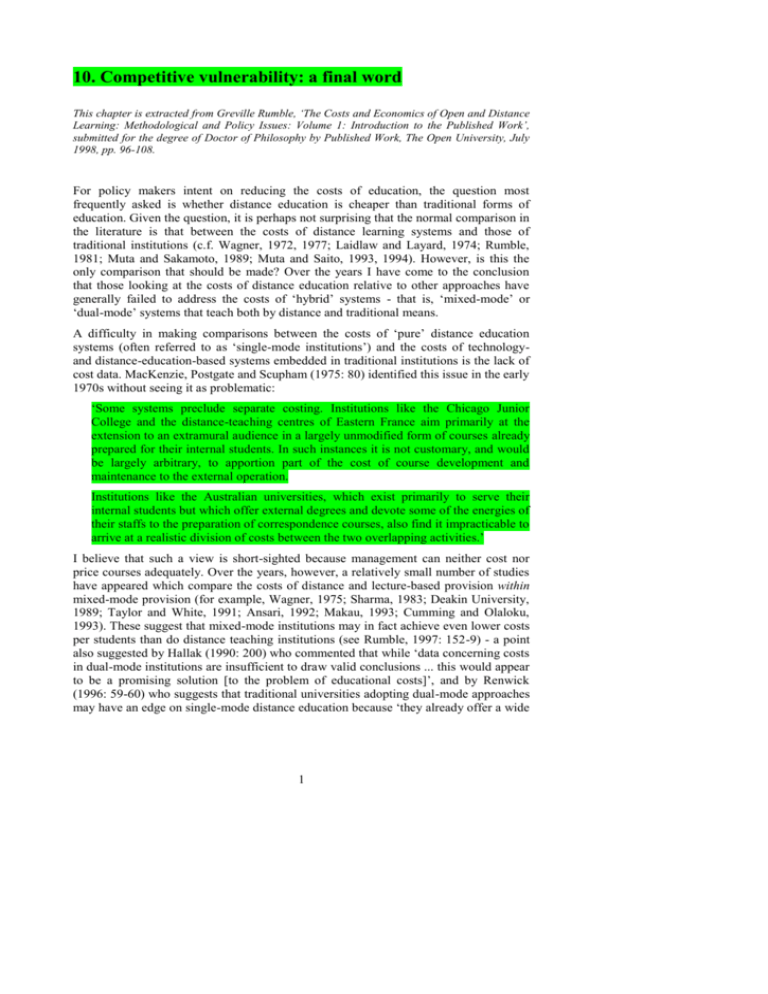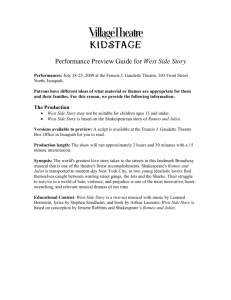RUMBLE Chap 10 FINAL 210403
advertisement

10. Competitive vulnerability: a final word This chapter is extracted from Greville Rumble, ‘The Costs and Economics of Open and Distance Learning: Methodological and Policy Issues: Volume 1: Introduction to the Published Work’, submitted for the degree of Doctor of Philosophy by Published Work, The Open University, July 1998, pp. 96-108. For policy makers intent on reducing the costs of education, the question most frequently asked is whether distance education is cheaper than traditional forms of education. Given the question, it is perhaps not surprising that the normal comparison in the literature is that between the costs of distance learning systems and those of traditional institutions (c.f. Wagner, 1972, 1977; Laidlaw and Layard, 1974; Rumble, 1981; Muta and Sakamoto, 1989; Muta and Saito, 1993, 1994). However, is this the only comparison that should be made? Over the years I have come to the conclusion that those looking at the costs of distance education relative to other approaches have generally failed to address the costs of ‘hybrid’ systems - that is, ‘mixed-mode’ or ‘dual-mode’ systems that teach both by distance and traditional means. A difficulty in making comparisons between the costs of ‘pure’ distance education systems (often referred to as ‘single-mode institutions’) and the costs of technologyand distance-education-based systems embedded in traditional institutions is the lack of cost data. MacKenzie, Postgate and Scupham (1975: 80) identified this issue in the early 1970s without seeing it as problematic: ‘Some systems preclude separate costing. Institutions like the Chicago Junior College and the distance-teaching centres of Eastern France aim primarily at the extension to an extramural audience in a largely unmodified form of courses already prepared for their internal students. In such instances it is not customary, and would be largely arbitrary, to apportion part of the cost of course development and maintenance to the external operation. Institutions like the Australian universities, which exist primarily to serve their internal students but which offer external degrees and devote some of the energies of their staffs to the preparation of correspondence courses, also find it impracticable to arrive at a realistic division of costs between the two overlapping activities.’ I believe that such a view is short-sighted because management can neither cost nor price courses adequately. Over the years, however, a relatively small number of studies have appeared which compare the costs of distance and lecture-based provision within mixed-mode provision (for example, Wagner, 1975; Sharma, 1983; Deakin University, 1989; Taylor and White, 1991; Ansari, 1992; Makau, 1993; Cumming and Olaloku, 1993). These suggest that mixed-mode institutions may in fact achieve even lower costs per students than do distance teaching institutions (see Rumble, 1997: 152-9) - a point also suggested by Hallak (1990: 200) who commented that while ‘data concerning costs in dual-mode institutions are insufficient to draw valid conclusions ... this would appear to be a promising solution [to the problem of educational costs]’, and by Renwick (1996: 59-60) who suggests that traditional universities adopting dual-mode approaches may have an edge on single-mode distance education because ‘they already offer a wide 1 range of degrees and qualifications that rival open universities, could diversify at less cost, would not necessarily have to rely on large numbers of enrolments to be viable as providers of distance programmes, and could offer a wider range of options to potential students’. Whether this is actually the case or not is as yet unclear. The Committee of Scottish University Principals (1992: 34-9, 41) found it impossible to come to a conclusion, as did Scott (1997) in his review of cost studies of the use of information technology assisted teaching and learning. However, it was the conviction that traditional institutions within the United Kingdom were not only adopting distance education methods but also undercutting the Open University’s prices (as reflected in the level of fees charged to students) that led me to write an article (Rumble, 1992) that focused on the competitive vulnerability of institutions such as the Open University when faced by such developments. In the mid-1970s Wagner (1975) had shown that campus-based universities could teach courses at a distance very cheaply by re-engineering their lecture courses into videobased formats (in effect, a by-product) suitable for off-campus teaching. However, the idea that re-engineering traditional higher education and making it more flexible might provide an even cheaper way of expanding higher education than by setting up singlemode distance education systems was not explored until quite recently. Partly this was because all Wagner had shown was that the additional costs of creating off-campus video-based teaching materials were very low. The cost of on-campus provision remained high. It seemed clear, though, that if traditional institutions could teach offcampus students more cheaply than could a distance teaching university, then they could also use similar resource-based teaching methods to teach their on-campus students, thus reducing their overall costs. The massification of higher education and the reduction in the unit of funding were the catalysts that forced higher education institutions to bring down their costs by reengineering their teaching processes. Evidence of the effect of this on costs emerged in a study by Taylor and White (1991), who compared the costs of (a) traditional oncampus lecture courses, (b) off-campus distance-based courses, and (c) on-campus reengineered flexible learning courses at the University College of Southern Queensland. They provided enough information to suggest how institutions adopting flexible learning for on- and off-campus students might teach a wider curriculum more cheaply than a single-mode distance teaching institution. I explored this idea in Rumble (1992) where I defined three kinds of universities: those that teach only on-campus by traditional face-to-face means (which I referred to as campus-based universities or CBUs) those that teach only by distance means to students wherever they live (called distance teaching universities or DTUs) those that teach both on-campus by traditional means and off-campus by distance means (called dual-mode universities or DMUs). In this article I sought to show that one of the strengths of DMUs is that they have distinct but often unrecognised economic advantages over DTUs. This contention was based on experience in Australia (Taylor and White, 1991) that suggested that DMUs can provide a broad curriculum comparatively cheaply to both on-campus students using traditional means of study, and to off-campus students studying by distance 2 means. In this they differ from DTUs, which can find it very difficult to provide a wide curriculum without jeopardising their cost advantage (c.f. Rumble, 1982: 136-7; 1987: 82-4; 1988a: 97-8). Some of the advantages of DMUs derive from accounting practices that allow costs to be allocated to the different on- and off-campus courses (products) in different ways - thus enabling the price charged to students to be modified at will (c.f. also, Rumble, 1997: 72-3). However, their real advantage stems from the fact that campus-based courses can be adapted for distance teaching purposes very cheaply, so that DMUs can often offer a wider choice of cheaper courses in distance format than can a DTU. Furthermore, in order to contain the costs of their on-campus teaching, more and more CBUs are beginning to develop flexible and resource based learning materials to teach their normal on-campus students. Once they have done this, they recognise that they can use the materials off-campus to gain a share of the distant-student market. They are becoming new competitors to the DTUs by, in effect, turning themselves into DMUs. DTUs are thus facing very significant competition for the first time. If widespread, this could put DTUs in a very vulnerable position. Although they appear monolithic, none of them is as large as the combined strength of the CBUs. If a large number of CBUs decide to enter the distance market, DTUs will face multiple competitors competing in their own secondary (off-campus) market for the DTU’s primary off-campus business. Ohmae (1983: 52) had shown how vulnerable such a position could be. DTUs can be undercut by the newly emergent DMUs using marginal costing as a basis of pricing, and outsold by the DMUs ability to offer a wider range of courses through a wide range of teaching strategies. DTUs faced by such competition have several options: (1) to do nothing; (2) to concentrate on doing what they do well - ‘sticking to the knitting’ and focusing on quality, in the knowledge that the newly emergent DMUs will find it hard to fund entry into the market (which requires diverting staff to new tasks while maintaining the old ones) and to match quality; and (3) to internationalise, seeking markets abroad. However, DTUs may also find it difficult to develop new products and to change their products rapidly, so another option (4) might be to buy the right to teach CBU courses in off-campus distance mode (through a licensing or franchise arrangement). What DTUs will find it hard to do is (5) to respond to competition head on, by developing new products (lead-in times for material development are too long) and by price-cutting. While there are a number of strategies, the best, though, might be (6) to turn themselves into a DMU by establishing an on-campus programme or by merging with a CBU. The Editor of Open Learning invited formal responses to the article from White (1992), Mugridge (1992) and Keegan (1994), and, subsequently, I was invited to reply to my critics (Rumble, 1994a). In his response to the article, White (1992: 59) held that the most significant step forward in teaching has been the growth of distance education - so much so that CBUs are now embracing it. However, CBUs will have to learn how to produce quality material. Indeed they should find it difficult to compete successfully in the distance education market because it is costly and time consuming to develop quality learning materials. The DTUs main strength is the quality of their products and, given their lead, they should have little to worry about, particularly as distance teaching methods can be as cheap or as expensive as one wishes to make them. However, it would be a mistake to cheapen methods at the expense of quality (p. 60). Rumble’s 3 comment that one way forward for DTUs is to turn themselves into DMUs should be taken seriously. What DTUs must most fear is their inability to maintain ‘a superior quality differential, or to find the additional resources or a partner to likewise become a DMU’ (p. 60). Mugridge (1992: 61) says the divide between distance and face-to-face teaching has become less sharp. He agreed that the emergence of DMUs has made DTUs vulnerable. Of all the feasible options presented by Rumble (1), doing nothing, is rightly rejected. The option of doing what they do well, better, is perhaps the one to concentrate on. But DTUs should not be too narrow in their definition of what distance education is: instead of competing with CBUs, they should use their strengths to collaborate. Their quality gives them a decided advantage over many CBUs - and they could bring this to a collaborative partnership with CBUs. Keegan (1994: 36) perceives the radicalism of some of Rumble’s suggestions (for example, that DTUs should become DMUs). Why is the model a competitive one, however? CBUs and DTUs need to work together. He argues that the free market development of DMUs was stopped in Australia on economic grounds, and because there are dangers in providing shoestring distance education services. The cost of improving the quality of such provision would have been too great, hence the Australian decision to concentrate distance education in a few institutions (p. 37). Some of the weaknesses of distance teaching universities referred to by Rumble (e.g. their ability to produce courses quickly) can be solved (p. 38). Equally, there are distance teaching universities with a full range of subjects. A decade ago Keegan and Rumble (1982: 246) suggested that the number of students at which a DTU would become more costefficient than a CBU was somewhere between 9,000 and 22,000 students - so that where a system is likely to enrol under 9000 students, a CBU is the cheapest option; where the enrolment is likely to be more than 22,000, a DTU is the cheapest option. The DMU option is difficult - because staff find it hard to work in traditional and distance modes at the same time. This 1982 guideline gave practical advice to government planners and distance education administrators. The most fruitful way forward is for DTUs and CBUs to co-operate. In my response to White, Mugridge and Keegan, I argued that the imperative for change is the search for improved productivity (Rumble, 1994a). The DTUs have acted as a catalyst and their methods are now being adopted by CBUs. Although DTUs start from a strong position (as White suggests), their position can be eroded rapidly as more and more CBUs enter their market. The fact that DMUs may not match the DTUs’ quality is not necessarily the point: students will follow the credentialling power of a university’s name, and funding will follow students. Quality is not the only factor of importance. These developments have opened up the possibility of competition. The fact that competition does not exist now for some DTUs does not mean that it will not in the future. True, the Australian government stepped in to curb competition because they saw it as unacceptable - but this was the government’s view. Individual institutions saw every reason to enter the distance education market, both to gain a share of that market and to develop materials that would allow them to reduce their on-campus costs. [Interestingly, this suggestion is borne out by the fact that by 1998 the attempt to curb entry into the distance market had clearly failed.] Collaboration, which Mugridge and Keegan urge, is inherently attractive, but many CBUs/DMUs have found it costly to 4 buy-in materials, and indeed cheaper to develop their own (Curran, 1993: 21; Robertshaw, 1993), so collaboration may not be that attractive to CBUs. The advantage may well lie with competition. So while it makes no sense at all to develop a DTU where enrolments are likely to be low, it does not follow that it is sensible to do so just because enrolments are likely to be high. This does not mean that it is never a sensible option. DTUs faced by competition from DMUs would do best to convert themselves into DMUs. Commenting on Rumble (1992), Bell and Tight (1993: 138) pointed out that: ‘Innovation is, of course, far from easy and inevitably constrained by circumstances. It would have been unreasonable, therefore, to have expected a greater move away from the then conventional patterns at the time when the Open University was established. Yet it has been disappointing to observe how little the University has developed from its original structure, and to note how restrictive this has become. It is reassuring, then, to see that some senior staff at the Open University are beginning to appreciate the competitive vulnerability of their position in the market (Rumble, 1992). This has become particularly apparent as alternative, cheaper and more flexible models of distance education and open learning have been developed; and as conventional institutions have increasingly moved into the market sector which had hitherto been occupied in the United Kingdom by the Open University alone.’ Evans and Nation (1993: 211, 214 passim) also discussed the article and concluded: ‘Despite their capacity to develop and deliver high quality courses in a cost-effective manner and to concentrate exclusively upon the needs of part-time students, distance teaching universities (DTUs) cannot compete effectively against dual-mode universities (DMUs). The latter have advantages in the flexibility of their teaching strategies and the wider range of courses they can offer (Rumble, 1992, pp. 33-5). To the surprise of some, no doubt, Rumble’s detailed economic analysis suggests that the DMUs can achieve more cost-efficiencies than their distance teaching counterparts (pp. 35 - 40). His conclusions have stark implications for the latter: ‘... the most effective response for a DTU may well be to turn itself into a DMU, either by establishing an on-campus programme, or by merging with a CBU [campusbased university]’ (Rumble, 1992: 43). ... If Rumble is right, there may be many distance teaching universities throughout the world looking for collaborative business with dual-mode and campus-based universities (1992: 40-43).’ Moore and Kearsley (1996: 235) summarise the article’s impact as follows: ‘Rumble (1992) ... explains that dedicated distance learning institutions are the most cost-effective way to provide distance education as long as they offer relatively few courses to large numbers of students. However, as the number of courses offered increases and the student enrolment per course becomes smaller, the economy of scale that favoured the [single mode] institutional model breaks down. ... What Rumble suggests is likely to happen is an increasing convergence (and perhaps some actual mergers) between distance education and traditional ‘classroom-based’ institutions.’ 5 Daniel (1996: 32) poses the challenge of the article as follows: ‘Now that all universities are exploring the possibility of teaching at a distance some argue that large institutions dedicated solely to distance teaching are no longer necessary. Others argue that because of their size and their commitment to industrial methods the mega-universities will not be nimble enough to survive in a post industrial age. Since this claim has been made by people with direct experience of mega-universities (Bates, 1995, p. 242; Raggatt, 1993; Rumble, 1992) some people now expect the eventual demise of the mega-universities. This chapter may assist judgements about their likely longevity.’ Elsewhere Daniel (1996: 68) approvingly cites Keegan’s (1994) defence of the competitive advantages of distance teaching universities and in particular his view that their size is a competitive advantage, and he then goes on himself to analyse where size will be an asset to the mega-universities as they adapt to a new generation of technologies. Daniel’s contention is that the eleven mega-universities, as a group, enrol 2.8 million students at an average institutional cost per student that is at most half that of the combined 182 higher education institutions in the UK (about $10,000 per student with 1.6 million students) or the 3,500 institution US higher education system (about $12,500 with some 14 million students) (Daniel, 1996: 32; 1998). This, however, compares the ‘mega-university’ system with systems that are still, in the main, highly traditional in their teaching methods. If the traditional system were to be fully reengineered, adopting open and flexible learning methods to teach off-campus and oncampus students in significant numbers by these means, the comparison might be somewhat different. Until such times as proper cost studies are undertaken, all we have is opinion. In the absence of proper research to inform decision makers, the better option is scepticism. Two questions remain: the first is why there have not been more comparisons between the costs of distance teaching institutions and the costs achievable in mixed-mode institutions. One reason is hinted at the beginning of this section, and borne out by my own research into the costing of mixed-mode provision (c.f. Rumble, 1997: 66-70), and that is the difficulty institutions have had in separating out their costs (see MacKenzie, Postgate and Scupham, 1975: 80). This difficulty arises not least because of the absence of activity based costing in mixed-mode institutions. Over and beyond this, I suggest that those working in distance education consciously or unconsciously have set up a dualism between distance education and traditional forms of education that precludes consideration of mixed-mode provision. There are a number of reasons for this dualism (Rumble, 1994b): First, in the 1970s and 1980s, when distance educators were beginning to articulate a theory of teaching at a distance, it was fairly easy to draw a sharp distinction between distance education and traditional face-to-face teaching. Distance education was ‘mediated’ in a way that traditional education was not. The growth of resourcebased learning and independent study has tended to remove this division. Second, there was a search for a theoretical basis for the separation between distance education and face-to-face teaching. Keegan (1986: 6), one of the seminal thinkers in the field, argued that ‘distance education is a coherent and distinct field of educational endeavour’. He called for the development of a ‘firmly-based theory of distance education. .... something that ... gives the foundation on which 6 structures of need, purpose and administration can be erected .... which can provide the touchstone against which decisions - political, financial, educational, social can be taken with confidence’; Holmberg (1986; 1989: 205-9; 1995: 207-13) suggested that distance education is a discipline in its own right - a view that I and others have criticised (Rumble, 1988b; Bell and Tight, 1993: 6). I also suggested that the search for a theoretical basis for separation was the result of deep insecurity about the status of distance education (Rumble, 1994b). Keegan (1986: 3), for example, refers to the long ‘Cinderella’ status of distance education which had set distance education apart from traditional education. The growth in confidence among distance educators, and the search for a theory that would set distance education apart from traditional education, ultimately reinforced the tendency to separatism. Several reasons might be adduced for this: for example, that distance educators continue to occupy a ‘laager’ position, in which they feel themselves to be isolated from other disciplines and subject areas, including mainstream educational thinking. The creation of a separate disciplinary position would act as an antidote to such isolationism, providing distance educators with a status they feel they otherwise lack. Alternatively, distance educators might perceive themselves as a highly organised group of ‘revolutionaries’ with their own journals, associations, and theoretical structures, who are engaged ‘in the process of formulating a radical conceptual reorganisation within their field [of education]’ (Griffith and Mullins [1972], cited in Becher [1989]). Or, as another alternative, distance educators might perceive separatism as a means to power - to the creation of chairs in distance education and departments of distance education. Any one of these scenarios might be supported by drawing on and emphasising different facts. Third, that there was a structural basis for separatism, in part derived from the use of media to teach, in part from the emphasis on a different target population, that was reinforced by the belief that distance education needed both separate administrative structures and different approaches to funding. From this position, it was not too great a step to suggest that distance education was best separated from traditional forms of education. This view was articulated by a number of distance education leaders in the 1970s (Peters, 1973: 310; Perry, 1976: 55; Daniel and Smith, 1979: 64), and was reinforced by the view that the very different cost structures of distance education warranted separate financing (Snowden and Daniel, 1980: 76; Swinerton and Hogan, 1981: 1). The second question is why, if there is such an advantage in mixed-mode provision, there has been relatively little collaboration between distance teaching and campusbased institutions. Various kinds of collaboration are possible including, for example: provision of technical advice, consultancy, and information to conventional universities interested in developing flexible and distance learning. This raises few problems. making use of the materials that a distance education system has available in order to provide distance-based options within a conventional setting. In theory both simple and desirable, Rumble (1994a: 48) refers to empirical evidence that campusbased institutions have found it more expensive to buy-in materials than to create their own, except where student numbers are very low (Robertshaw, 1993: 111; Curran, 1994: 3), and that they can create their own distance teaching materials 7 very cheaply (Fwu et al., 1992; Sharratt, 1993: 119). More widely, Neil (1981: 1726) and Moran and Mugridge (1993: xiii, 5, 9-10, 152-7) have identified a range of factors inhibiting collaboration. These include the existence of cultural differences between institutions; traditions of institutional autonomy; the ‘Not Invented Here’ syndrome; poorly constituted collaborative objectives; a failure to articulate mutual benefits; lack of clarity in specifying the terms of an agreement; incompatible organisational structures and administrative procedures; inadequate funds to implement an agreement; poor interpersonal relations between those involved in collaboration; weak leadership; lack of any real commitment on the part of one or more of the parties to making the agreement work; and lack of trust. credit transfer agreements enabling students to use credits gained at participating traditional and distance institutions towards the qualifications offered by these institutions. Experience suggests that such agreements are easy to articulate, but much harder to turn into practical outcomes, given a reluctance to recognise studies taken elsewhere. the creation of new management structures between a group of collaborating institutions, designed to facilitate collaboration. The National Technological University (NTU) in the USA is a good example, linking as it does the NTU functioning as an administrative and co-ordinating unit with the engineering departments of over thirty traditional universities, to teach graduate engineers in their workplaces. In the case of the NTU, success flows from the fact that the participating engineering departments located in conventional institutions, and the individual lecturers in those departments, gained from their collaboration with NTU (Fwu et al., 1992: 128). On the other hand Fwu and his colleagues suggest that ‘attempting to replicate NTU in other countries may be impossible, as it is a unique US product. The past experience of universities working independently with distance learning, and later working together in [a consortium] may be lacking’ (p.128). Perhaps the greatest impediment to collaboration is the fact that any conventional institution adopting distance education has to revolutionise its teaching. This includes focusing its academic staff on supporting learners rather than teaching students, and replacing lecture theatres with help desks and individual consultation rooms. Significantly, evidence from those working within traditional institutions suggests that it can be extremely difficult to interest ‘traditional’ academics in open and distance learning (Lewis, 1994; Bashir, 1998; Lueddeke, 1998), and this would presumably extend to collaboration with distance education providers. For distance education providers, especially at university level where autonomy is important, there is the fear that they will become ‘junior’ partners in a relationship - the ‘materials production wing’ of the collaboration, focusing at most on the teaching of high-enrolment, lowerlevel courses, while leaving the more academically challenging specialist courses to be taught by their on-campus colleagues. 8 References Ansari, M. M. (1992). Economics of distance higher education. New Delhi: Concept Publishing Company. Bashir, T. H. (1998). Dangerous liaison: Academics’ attitude towards open learning in higher education. Open Learning, 13 (1), pp. 43-45. Bates, A. W. (1995). Technology, Open Learning and Distance Education. London: Routledge. Becher, T. (1989). Academic tribes and territories. Intellectual enquiry and the culture of disciplines. Milton Keynes: Open University Press. Bell, R. & Tight, M. (1993). Open universities: a British tradition? Buckingham: The Open University Press. Committee of Scottish University Principals (1992). Teaching and learning in an expanding higher education system. Edinburgh: CSUP. Cumming, C. & Olaloku, F. A. (1993). The Correspondence and Open Studies Institute, University of Lagos. In H. Perraton, (ed.) Distance education for teacher training. London: Routledge. Curran, C. (1993). Scale, cost and quality in small distance teaching universities. In H. Siggard Jensen & S. Siggard Jensen (eds.). Organization, technology and economics of education. Proceedings of the COSTEL Workshop, Copenhagen, 11-12 January 1993, Copenhagen: n.p. Daniel, J. S. (1996) Mega-universities and knowledge media. Technology strategies for higher education. London: Kogan Page. Daniel, J. S. & Smith, W. A. S. (1979). Opening open universities: the Canadian experience. Canadian Journal of Higher Education, 9 (2), pp. 63-74. Deakin University (1989). Further investigations into activity costing in a mixed mode institution. Department of Employment, Education and Training, Commonwealth of Australia. Evans, T. & Nation, D. (eds.) (1993). Reforming open and distance education. Critical reflections from practice. London: Kogan Page. Fwu, B.-j., Jamison, D., Livingston, R., Oliveira, J., Skewes-Cox, T., & Van der Kelen, B. (1992). The National Technological University. In G. Rumble & J. Oliveira. (eds.). Vocational education at a distance: International perspectives. London: Kogan Page. Hallak, J. (1990). Investing in the future. Setting educational priorities in the Developing World. Paris, UNESCO: International Institute for Educational Planning and Pergamon Press. Holmberg, B. (1986). A discipline of distance education. Journal of Distance Education, 1 (1), pp. 25-40. Holmberg, B. (1989, 1st. edn.). Theory and practice of distance education. London: Routledge. 9 Holmberg, B. (1995, 2nd. edn.). Theory and practice of distance education. London: Routledge. Keegan, D. (1986, 1st. edn.). Foundations of distance education. London: Croom Helm. Keegan, D. (1994). The competitive advantages of distance teaching universities. Open Learning, 9 (2), pp. 36-9. Keegan, D. & Rumble, G. (1982). The DTUs: an appraisal. In G. Rumble & K. Harry (eds.). The distance teaching universities. London: Croom Helm. Laidlaw, B. & Layard, R. (1974). Traditional versus Open University teaching methods: a cost comparison. Higher Education, 3 (4), pp. 439-68. Lewis, R. (1994). Embedding open learning in higher education. In M. Thorpe & D. Grugeon, (eds.). Open learning in the mainstream. London: Longman. Lueddeke, G. (1998). The management of change towards an open learning framework: An higher education inquiry. Open Learning, 13 (3), 3-17. MacKenzie, N., Postgate, R. & Scupham, J. (1975). Open learning. Systems and problems in post-secondary education. Paris: The UNESCO Press. Makau, B. (1993). The external degree programme at the University of Nairobi. In H. Perraton (ed.). Distance education for teacher training. London: Routledge. Moore, M. G. & Kearsley, G. (1996). Distance education. A systems view. Belmont, Calif.: Wadsworth Publishing Company. Moran, L., & Mugridge, I. (1993). Collaboration in distance education. International case studies. London: Routledge. Mugridge, I. (1992). Responses to Greville Rumble’s article ‘The competitive vulnerability of distance teaching universities’. Open Learning, 7 (3), pp. 61-2. Muta, H. & Sakamoto, T. (1989). The economics of the University of the Air of Japan revisited. Higher Education, 18 (5), pp. 585-611. Muta, H. & Saito, T. (1993) Economics of the expansion of the University of the Air of Japan. In Asian Association of Open Universities. Economics of distance education. AAOU VIIth Annual Conference 1993, Hong Kong, Open Learning Institute of Hong Kong. Muta, H. & Saito, T. (1994). Comprehensive cost-analysis of the University of the Air of Japan. Higher Education, 28 (3), pp. 325-353. Neil, M. (1981) Education of adults at a distance. A report of the Open University’s tenth anniversary conference. London: Kogan Page. Perry, W. (1976). Open University. A personal account by the first Vice-Chancellor. Milton Keynes: Open University Press. Peters, O. (1973). Die didaktische Struktur des Fernunterrichts Untersuchungen zu einer industrialisierten Form des Lehrens und Lernens. Weinheim: Beltz. Raggatt, P. (1993). Post-Fordism and distance education - a flexible strategy for change. Open Learning, 8 (1), pp. 21-31. 10 Renwick, W. (1996). The future of face-to-face and distance teaching in post-secondary education. In OECD. Information Technology and the future of post-secondary education. Paris: OECD. Robertshaw, M. (1993). The importation and adaptation of distance education courses: is it an expensive option? In Asian Association of Open Universities. Economics of distance education. AAOU VIIth Annual Conference 1993, Hong Kong, Open Learning Institute of Hong Kong. Rumble, G. (1981). The cost analysis of distance teaching. Costa Rica’s Universidad Estatal a Distancia. Higher Education, 10, pp. 375-401. Rumble, G. (1982). The cost analysis of learning at a distance: Venezuela’s Universidad Nacional Abierta. Distance Education, 3 (1), pp. 116-40. Rumble, G. (1987). Why distance education can be cheaper than conventional education. Distance Education, 8 (1), pp. 72 - 94. Rumble, G. (1988a). The economics of mass distance education. Prospects, XVIII (1), pp. 91-102. Rumble, G. (1988b). Animadversions upon the concept of distance education as a discipline. Journal of Distance Education, 3 (1), pp. 39-56. Rumble, G. (1992). The competitive vulnerability of distance teaching universities. Open Learning 7 (2), pp. 31-49. Rumble, G. (1994a). The competitive vulnerability of distance teaching universities: a reply. Open Learning, 9 (3), pp. 47-9. Rumble, G. (1994b). Mixed modes of teaching and learning: structures, resources, and developments. In M. Thorpe, M. & D. Grugeon (eds.) Open Learning in the Mainstream. London: Longman. Rumble, G. (1997). The Costs and Economics of Open and Distance Learning. London: Kogan Page. Scott, P. (1997). The economic costs and benefits of Information Technology assisted teaching and learning: A literature overview. In Higher Education Funding Council for England. Information Technology assisted teaching and learning in higher education. Bristol: HEFCE. Sharma, R. D. (1983). The economics of distance education in an integrated tertiary education system. In Australian and South Pacific External Studies Association. Papers of the ASPESA Sixth Biennial Forum, Toowomba, 11-15 July 1983, ASPESA, pp. 163-75. Sharratt, R. (1997). Innovation in a traditional setting at Sheffield University. In S. Brown (ed.). Open and distance learning: Case studies from industry and education. London: Kogan Page. Snowden, B. L. & Daniel, J. S. (1980). The economics and management of small postsecondary distance education systems. Distance Education, 1 (1), pp. 68-91. Swinerton, E. N. & Hogan, T. P. (1981). A tested budget model for a nontraditional degree program. Madison: Wisconsin: University of Wisconsin, mimeo. 11 Taylor, J. C. & White, V. J. (1991). The evaluation of the cost-effectiveness of multimedia mixed-mode teaching and learning. Canberra: Australian Government Publishing Service. Wagner, L. (1972). The economics of the Open University. Higher Education, 1 (2), pp. 159-83. Wagner, L. (1975). Television video-tape systems for off-campus education: A cost analysis of SURGE. Instructional Science, 4 (2), pp. 315-32. Wagner, L. (1977). The economics of the Open University revisited. Higher Education, 6 (3), pp. 359-81. White, V. J. (1992). Responses to Greville Rumble’s article ‘The competitive vulnerability of distance teaching universities’. Open Learning, 7 (3), pp. 59-60. 12






